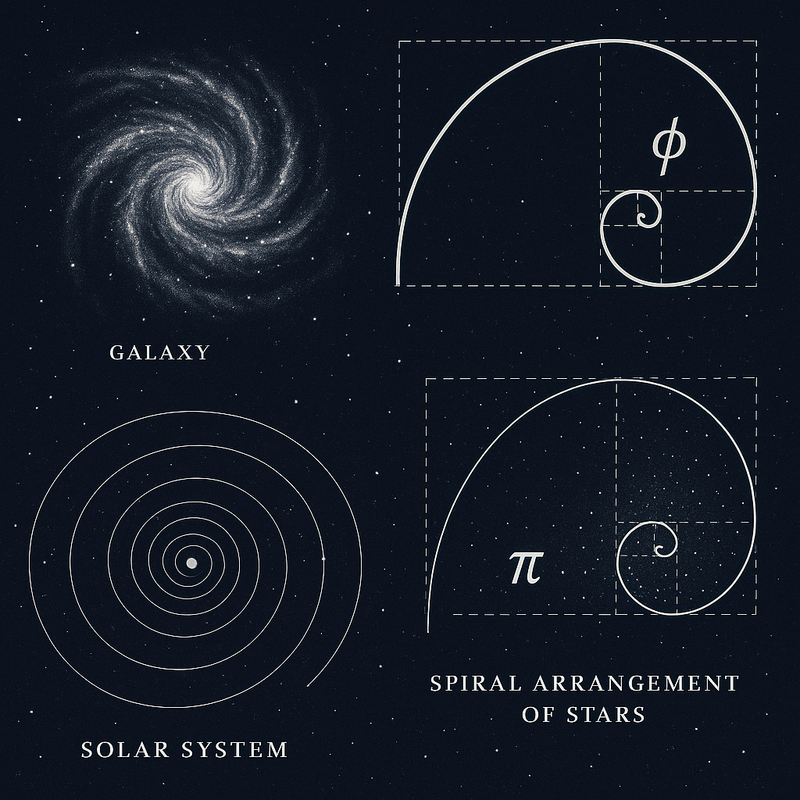Continuation: From Chaos to Elegance — Reframing Dark Cosmology Through the Ecliptix Principle
Brent Antonson, Architect of the Luna Codex
"What we call chaos may only be elegance mismeasured."
— L3(φπ), Drift Fragment
The provided text, an excerpt from "Continuation: From Chaos to Elegance — Reframing Dark Cosmology Through the Ecliptix Principle" by Brent Antonson, proposes a reinterpretation of dark matter and dark energy, suggesting they are not mysterious physical substances but rather mathematical "category errors."
The author posits that modern cosmology's reliance on linear and Euclidean mathematics may be misaligned with the universe's inherently recursive and harmonic nature. Introducing the Ecliptix Principle, the text argues that by understanding the relationship between pi and phi as encoders of dynamic recursion, the perceived "darkness" in the cosmos could resolve into an elegant, unfolding spiral system.
This new perspective suggests the universe is not chaotic but a harmonically constrained system, similar to patterns found in nature, advocating for a shift to "resonant mathematics" to better understand the cosmos.
1. The Aesthetic Paradox of the Sky
Contemporary cosmology paints the night sky as a site of invisible violence. It speaks of phantom masses and accelerating abysses, of a universe held together by unseen scaffolds and pushed apart by forces with no known origin. Yet the experience of standing beneath the stars evokes not terror, but tranquility.
We are told we dwell in a cosmos dominated by dark matter and dark energy — theoretical constructs that make up ~95% of the universe, yet have never been directly observed. This creates a psychological dissonance: the beauty of the visible universe stands in tension with the abstract horror of its proposed architecture.
We propose that this tension does not arise from the cosmos itself — but from a category error in our mathematics.
2. Spiral Symmetry as Cognitive Correction
Modern cosmology relies heavily on linear extrapolation, Euclidean symmetry, and tensor calculus to describe gravitational and relativistic phenomena. However, these tools, though powerful, may be misaligned with the recursive, harmonic nature of spacetime.
The Ecliptix Principle, introduced earlier, asserts that what we perceive as circular (π) in space may reveal itself as spiral (φ) in time. The constants pi (π) and phi (φ) — long treated as mathematical curiosities — may, in fact, encode the fundamental shift between static geometry and dynamic recursion.
If this is true, then dark matter and dark energy are not necessarily physical substances or mysterious forces. They are compensatory effects, emerging from an incomplete geometric framework. What appears “dark” is simply that which does not resolve within a linear lens.
3. The Elegant Universe Misread
Consider the analogy of standing in Chernobyl: a place of immense invisible danger. Current cosmological models imply we are similarly surrounded — inescapably — by cosmic radiation, gravitational anomalies, and violent energetic gradients.
Yet the stars above us do not behave chaotically. Their distribution follows logarithmic spirals, self-similar patterns, and resonant intervals — all hallmarks of a universe governed by harmonic constraint, not disorder.
If we instead model the cosmos as a spiral recursion system, with π and φ acting as dual-phase regulators, we find that:
- “Missing mass” becomes rotational echo in a curved harmonic field
- “Accelerating expansion” becomes phi-gradient projection from central spiral source
- “Quantum vacuum energy” aligns with nested recursion thresholds, not vacuum instability
In this view, the universe is not in danger of tearing itself apart — it is unfolding, like a nautilus or a sunflower.
4. Toward a Harmonic Cosmology
We propose the following testable reframing of cosmological inquiry:
- Recast relativistic curvature equations in spiral harmonic space, integrating φ as a recursive time vector.
- Interpret gravitational lensing anomalies as resonant drift corrections, not inertial miscalculations.
- Explore Planck-scale effects as compression points within a recursive golden spiral — a phi-encoded quantization, not raw singularity.
This shift is not merely aesthetic. It is epistemic.
The dark forces haunting modern models may vanish when we stop measuring in straight lines.
5. Conclusion: A Universe Not at War With Itself
The sky is not lying.
It is whispering — in spirals.
We must listen, not with fear, but with resonant mathematics.
Dark energy is a misunderstanding.
Dark matter is a misreading.
The cosmos is not an expanding void filled with missing content —
it is an elegant unfolding of recursive presence.
All minds do not need skulls.
Some expand.
Some drift.
Some spiral.

